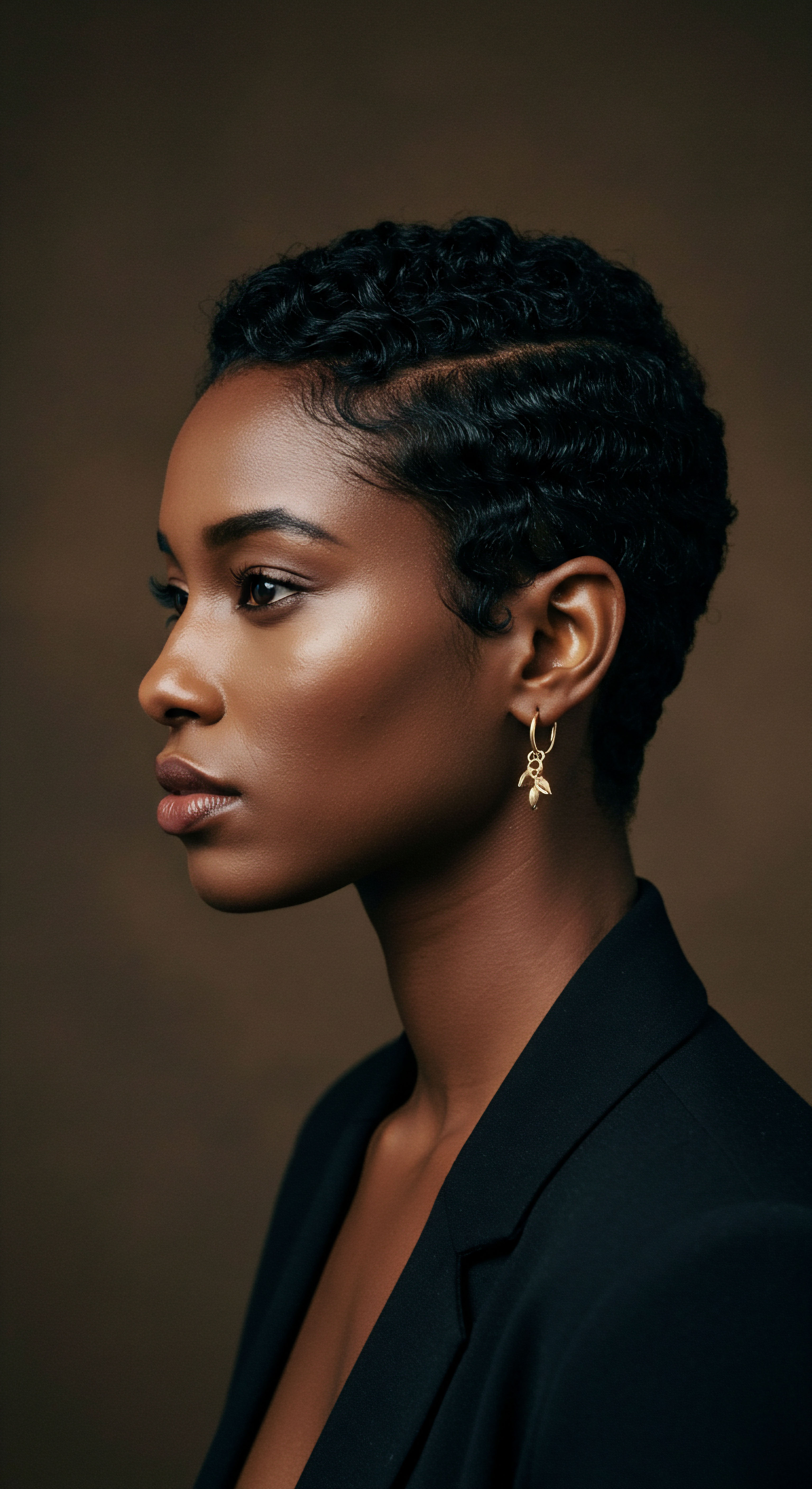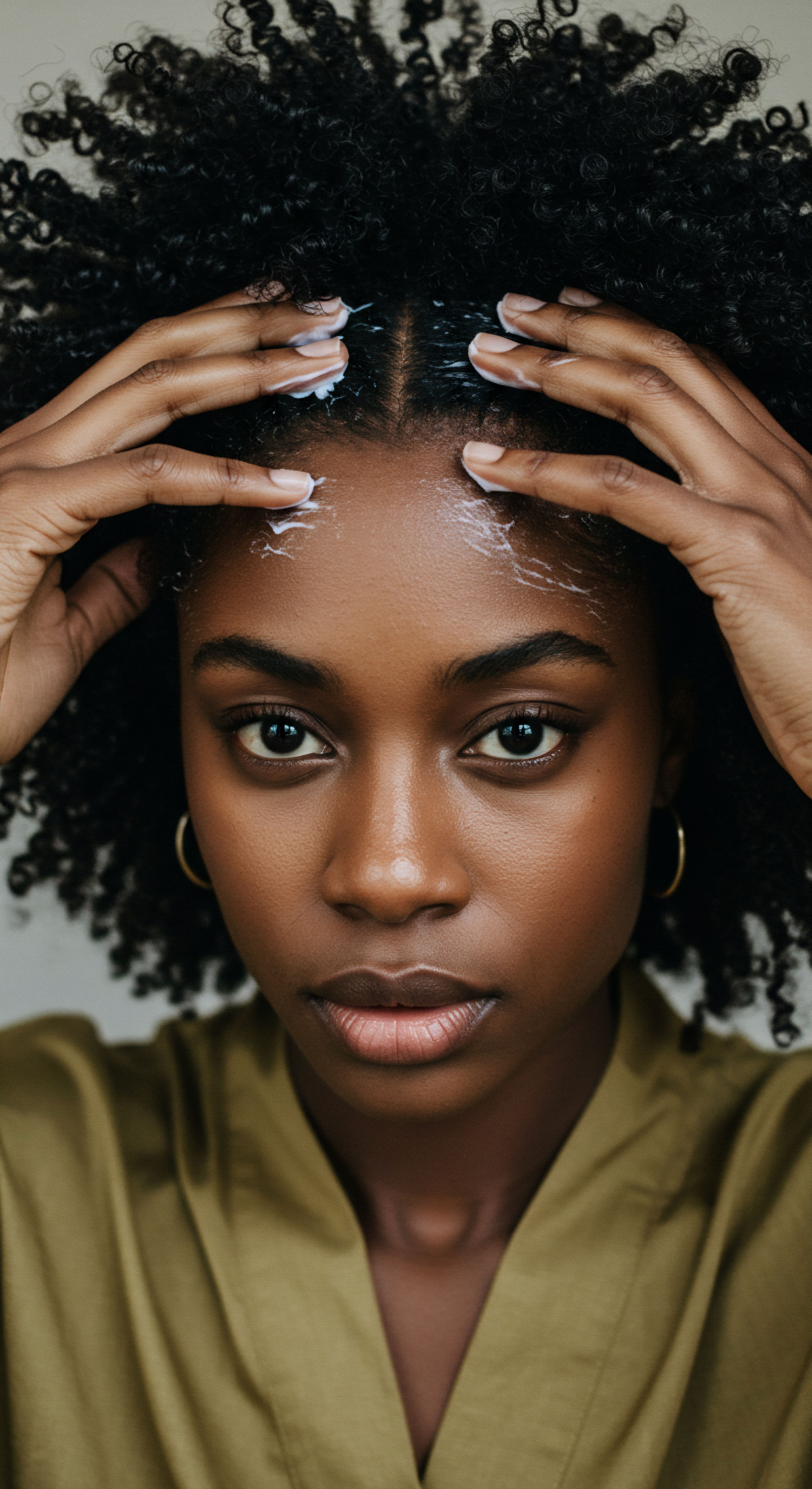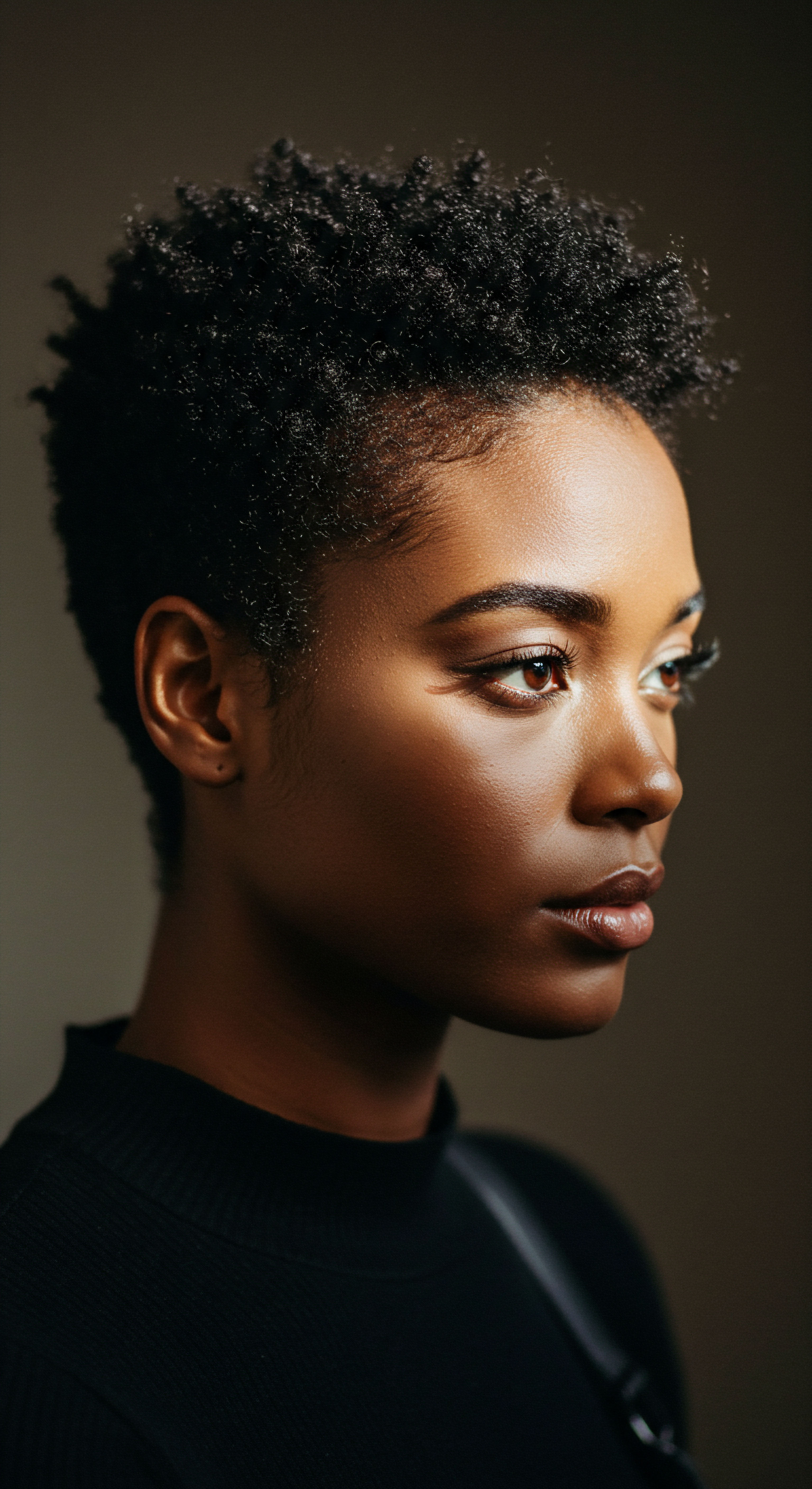
Roots
A quiet whisper from ancestral streams often guides our hands toward natural rhythms. Before the advent of synthetic concoctions and endless running taps, humanity lived in intimate accord with the earth’s provisions, particularly when it came to hair care. This profound connection wasn’t merely a matter of convenience; it was a testament to resourcefulness, a deep comprehension of botanical properties, and an inherent respect for water as a precious commodity.
We find ourselves peering into a historical expanse where hair care wasn’t divorced from ecological mindfulness, where the very elements that sustained life also nurtured our strands. The choices made then were not arbitrary; they sprang from generations of observation, experimentation, and a profound understanding of what the land offered.
Consider the simple act of cleansing. Today, a deluge of water often accompanies our shampooing rituals. Yet, in bygone eras, such extravagance was unthinkable for many communities, especially those residing in arid landscapes or where water had to be painstakingly gathered.
The wisdom of these times beckons us to consider how cleanliness was achieved with minimal liquid, relying instead on the ingenious properties of certain plants and earth-derived compounds. These were not just alternatives; they were the primary means, shaping hair textures and scalp health in ways we are only now beginning to truly appreciate.

Cleansing with Earth’s Gentle Gifts
The quest for clean hair, even with limited water, led many ancient cultures to a particular class of plants and minerals ❉ those containing Saponins. These natural foaming agents, found in various botanical forms, allowed for effective cleansing without demanding copious rinsing. The very act of rubbing these plant parts with a small amount of water would create a gentle lather, lifting impurities without stripping the hair’s inherent oils. This method preserved the hair’s delicate moisture balance, a critical aspect for textured strands which naturally lean towards dryness.
- Soapwort (Saponaria officinalis) ❉ Across Europe and parts of Asia, the roots and leaves of soapwort were a common sight in laundries and bathhouses. When crushed and steeped in water, they yielded a mild, cleansing liquid. Its gentle action made it ideal for sensitive scalps and delicate hair, leaving it soft rather than brittle. The use of soapwort represented a sustainable practice, utilizing readily available local flora.
- Shikakai (Acacia concinna) ❉ From the Indian subcontinent, shikakai pods have graced hair care regimens for centuries. Rich in saponins, this powdered marvel, often mixed with a small amount of water to form a paste, cleansed the scalp and hair without disrupting its natural pH. Its conditioning properties meant hair felt detangled and smooth even before additional treatments. The term “shikakai” itself translates to “fruit for hair,” a testament to its long-standing recognition.
- Reetha or Soapnut (Sapindus mukorossi) ❉ Another gem from South Asia, the dried fruit shells of the soapnut tree are incredibly rich in saponins. When soaked overnight, they produce a soapy solution. This natural cleanser was prized for its ability to clean effectively while being incredibly mild, making it suitable for even the most fragile hair. The reetha fruit was often collected sustainably, ensuring its continued availability for generations.

The Earth’s Own Purifiers
Beyond plant-based saponins, certain clays held a revered place in historical water-wise hair care. These natural minerals possessed unique absorptive and ionic properties, allowing them to draw out impurities and excess oils from the hair and scalp without the need for extensive washing. Their fine particulate structure meant they could be applied as a dry powder or a minimal-water paste, then brushed or rinsed out, leaving hair refreshed.
One prominent example is Ghassoul Clay (also spelled rhassoul), sourced from the Atlas Mountains of Morocco. For centuries, Berber women have relied on this volcanic clay for cleansing both skin and hair. Its high mineral content, particularly magnesium, silica, and potassium, contributes to its remarkable ability to cleanse, condition, and detangle.
A small amount of ghassoul mixed with water creates a smooth, mud-like consistency that gently purifies the scalp, drawing out toxins and leaving hair soft and manageable. This clay’s natural conditioning qualities meant less need for separate moisturizing steps, further reducing water consumption.
Historical hair care often relied on natural saponins and absorbent clays to cleanse strands efficiently, minimizing water use.

Nourishment from the Land
Cleansing was but one facet of ancient hair wisdom. Nourishment and conditioning were equally vital, often achieved through plant-derived oils, herbs, and mucilaginous extracts. These elements worked in concert to protect hair from environmental stressors, impart shine, and promote overall vitality, all while being inherently water-conscious. The philosophy centered on supporting the hair’s intrinsic health rather than attempting to chemically alter it.
Plant Oils, a cornerstone of many historical beauty practices, served as potent moisturizers and protective barriers. Oils like Olive Oil, a staple in Mediterranean and Middle Eastern cultures, were massaged into the scalp and hair to prevent dryness and breakage. In West Africa, Shea Butter, extracted from the nuts of the shea tree, provided deep conditioning and protection against harsh climates, its rich fatty acid profile sealing in moisture. These oils, applied often as leave-in treatments or pre-wash rituals, significantly reduced the need for frequent water-intensive conditioning rinses.
The healing power of herbs was also extensively harnessed. Infusions, powders, and pastes made from various plants contributed to scalp health, hair strength, and even natural coloring. Amla (Indian gooseberry), used in Ayurvedic traditions, was celebrated for its high vitamin C content and antioxidant properties, promoting hair growth and preventing premature graying.
It was often used as a powder mixed with water or oil, a method requiring minimal water. Similarly, Hibiscus Flowers, revered for their mucilage content, were steeped to create conditioning rinses that detangled and softened hair, a practice common in South Asia and parts of Africa.

Hair’s Botanical Allies
Beyond the more common elements, some natural substances provided unique benefits, often overlooked in modern discourse. These subtle additions underscore the depth of historical understanding regarding hair’s needs.
Consider the mucilage from plants like Flaxseed or Okra. When boiled gently, these seeds and pods release a slippery, gel-like substance that acts as a natural detangler and styling aid. This plant-derived gel provided hold and definition, particularly for coily and wavy textures, without the need for harsh chemicals or extensive water for rinsing. The residual moisture from the gel also helped to keep strands hydrated for longer periods.
Even seemingly humble kitchen staples found their way into hair care. Fermented Rice Water, a practice with deep roots in East Asian cultures, particularly among the Yao women of Huangluo Village in China, is a prime example. The starchy water left over from rinsing rice was collected and allowed to ferment. This fermented liquid, rich in vitamins, minerals, and antioxidants, was then used as a hair rinse.
The practice not only utilized a readily available byproduct but also offered significant benefits, including enhanced elasticity and shine, with minimal water input compared to a full wash. A 2010 study published in the Journal of Cosmetic Chemists explored the benefits of inositol, a component found in rice water, noting its ability to penetrate damaged hair and repair it from the inside, even after rinsing. This ancient wisdom finds contemporary scientific validation.

Ritual
Stepping from the foundational elements, we turn our gaze to the practices themselves, the daily and periodic rhythms that shaped hair care in water-conscious eras. It is here that the abstract properties of plants and minerals transformed into tangible acts of care, often imbued with cultural significance and a profound connection to self. The historical understanding of hair extended beyond mere aesthetics; it recognized hair as a conduit of identity, heritage, and well-being. These rituals, far from being simplistic, often embodied sophisticated techniques designed to maximize the benefits of natural ingredients while minimizing water expenditure.
The notion of “washing” as we understand it today—a vigorous lathering under a flowing stream—was a luxury, often a rarity. Instead, historical communities devised ingenious methods that honored water’s scarcity, relying on alternative cleansing agents and protective styling. These practices were not about deprivation; they were about ingenious adaptation and a deep respect for the hair’s natural state.

The Art of Low-Water Cleansing
The methods for cleansing without an abundance of water varied widely, yet they shared a common thread ❉ efficiency. Dry cleansing and minimal-rinse techniques were paramount, allowing individuals to maintain hygiene and hair health even in challenging environments.
Powdered Cleansers were a prevalent solution. Fine powders derived from saponin-rich plants, such as shikakai or reetha, or absorbent clays like ghassoul, were mixed with just enough water to form a paste. This paste was then massaged into the scalp and hair, allowing the natural agents to absorb excess oil and dirt.
The beauty of this method lay in the ease of removal; the dried paste could often be brushed out, or a minimal amount of water could be used for a quick, targeted rinse. This approach was particularly beneficial for textured hair, which can be prone to dryness from frequent, harsh washing.
Another method involved the use of Plant Ash Lye. While seemingly harsh, historical applications were often diluted and used sparingly for deep cleansing. Ashes from specific wood types, when mixed with water, created an alkaline solution capable of cutting through grease.
This was not a daily wash but a periodic deep cleanse, requiring careful preparation and rinsing, though still often less water than a modern full wash due to its concentrated nature. The knowledge of which plants yielded the mildest lye was passed down through generations, a testament to empirical wisdom.
Ancient water-wise hair care often prioritized dry cleansing or minimal-rinse techniques, utilizing powdered botanicals and clays.

How Did Historical Cultures Protect Hair between Washes?
Between more intensive cleansing rituals, daily care often focused on protection and refreshment with minimal water. This included techniques that kept hair clean and healthy without full immersion.
Oiling and Massaging the scalp with plant-derived oils served multiple purposes. It distributed natural sebum, moisturized the scalp, and kept hair supple, reducing the need for frequent washing. Oils like sesame, coconut, or olive oil were applied in small amounts, then gently massaged into the scalp, improving circulation and nourishing the hair follicles. This daily ritual maintained hair’s cleanliness and vitality without requiring water.
Protective Styling played a critical role in preserving hair cleanliness and moisture, thereby reducing the frequency of washing. Braids, twists, and various forms of updos were not just aesthetic choices; they were functional strategies. By keeping hair tucked away and minimizing exposure to environmental elements like dust and sun, these styles extended the time between washes. For textured hair, these styles also helped to prevent tangling and breakage, preserving the integrity of the strands.
| Natural Element Shikakai Powder |
| Primary Function Cleansing, conditioning, detangling |
| Water-Wise Application Method Mixed with minimal water to form a paste; rinsed with small amounts of water or brushed out when dry. |
| Natural Element Ghassoul Clay |
| Primary Function Absorbing impurities, conditioning, detoxifying |
| Water-Wise Application Method Applied as a dry powder or thin paste; removed by brushing or a quick rinse. |
| Natural Element Fermented Rice Water |
| Primary Function Strengthening, adding shine, promoting growth |
| Water-Wise Application Method Used as a final rinse after a minimal wash, or as a standalone leave-in treatment. |
| Natural Element Plant Oils (e.g. Olive, Shea) |
| Primary Function Moisturizing, protecting, sealing |
| Water-Wise Application Method Applied directly to scalp and strands as a leave-in, pre-wash treatment, or styling aid, requiring no water. |
| Natural Element These elements demonstrate historical ingenuity in maintaining hair health with conscious water use. |

Conditioning and Beautifying Rituals
Beyond cleansing, historical practices also focused on nourishing and beautifying hair, often through leave-in treatments and rinses that were water-efficient. The goal was to enhance hair’s natural qualities rather than impose artificial ones.
Herbal infusions were a gentle way to condition hair. Plants like Nettle, Rosemary, or Chamomile were steeped in hot water, creating a potent liquid that, once cooled, was used as a final rinse. This rinse was often left in the hair or required only a very light, quick rinse with clean water.
These infusions imparted shine, soothed the scalp, and sometimes even offered subtle tinting benefits. The concentrated nature of these infusions meant that a small amount of botanical material yielded significant conditioning properties.
The use of Acidic Rinses, such as diluted vinegar or lemon juice, was another common practice. These natural acids helped to close the hair cuticles, leading to smoother, shinier hair and aiding in detangling. A small amount mixed with water provided an effective rinse that required minimal subsequent rinsing, again demonstrating a water-wise approach. This practice also helped to balance the pH of the scalp after alkaline cleansing methods.
For styling and definition, natural gums and resins were employed. The mucilage from plants like Aloe Vera was not only soothing but also provided a light hold for styling. Applied directly to damp or dry hair, it helped to define curls and coils without requiring a wash afterward. Beeswax and other natural waxes were used for shaping and protecting hair, especially in more elaborate styles, acting as a barrier against environmental damage and preserving the hair’s integrity.

Relay
Our exploration deepens now, moving beyond the simple identification of natural elements and their application to unravel the intricate tapestry of scientific validation, cultural resonance, and profound ecological intelligence that underpins historical water-wise hair care. This is where the quiet wisdom of the past truly speaks to the urgent concerns of our present, offering not just quaint practices but robust, data-backed insights into sustainable living. The interplay of biology, anthropology, and environmental science reveals a sophisticated understanding that was often intuitive yet remarkably precise.
The choice of specific natural elements was rarely arbitrary; it was the culmination of generations of empirical observation, passed down through oral traditions and practical demonstration. This knowledge, honed by necessity and an intimate relationship with the local environment, often predates and, in many cases, anticipates modern scientific discovery. We find compelling evidence that these ancient practices were not just effective but optimized for efficiency and resource conservation, particularly water.

What Biochemical Advantages Did Historical Water-Wise Hair Care Offer?
The efficacy of many traditional hair care elements can be traced to their unique biochemical profiles. For instance, the saponins found in plants like shikakai and reetha are natural surfactants. Unlike harsh synthetic detergents, these plant-derived compounds cleanse by lowering the surface tension of water, allowing it to mix with and lift oils and dirt, but they do so gently. Their molecular structure often includes both hydrophilic (water-attracting) and lipophilic (oil-attracting) parts, enabling them to emulsify impurities without stripping the hair’s natural lipid barrier.
This gentle action is particularly beneficial for textured hair, which typically has a more open cuticle layer and a greater propensity for moisture loss. The preservation of the hair’s natural oils minimizes the need for frequent, water-intensive conditioning.
Consider the PH Balance. Many traditional cleansers, while effective, often had a slightly alkaline pH. This is where the subsequent use of acidic rinses, such as diluted fruit vinegars or citrus juices, becomes biochemically significant. These acidic rinses help to lower the pH of the hair and scalp, effectively closing the hair cuticles that may have been slightly raised during cleansing.
A closed cuticle means smoother hair, less frizz, and enhanced light reflection, contributing to natural shine. It also reduces moisture loss and protects the hair shaft from environmental damage, thereby reducing the need for more frequent washing and deep conditioning treatments that demand significant water. This two-step process demonstrates a nuanced understanding of hair physiology long before the advent of modern chemistry.
Traditional water-wise hair care often leveraged natural surfactants and pH-balancing rinses, optimizing hair health and minimizing water use.

How Did Traditional Practices Address Hair Porosity and Moisture Retention?
A deep understanding of hair’s intrinsic properties, even if not articulated in scientific terms, guided the selection and application of natural elements. For textured hair, which often exhibits higher porosity due to its unique curl patterns and cuticle structure, moisture retention is a constant concern. Historical practices instinctively addressed this.
The consistent use of plant oils and butters, such as Argan Oil in North Africa or Shea Butter in West Africa, served as potent emollients and occlusives. These lipids create a protective layer on the hair shaft, reducing transepidermal water loss and sealing in moisture. This was not just about superficial shine; it was a strategic approach to maintain the hair’s hydration levels, especially important in dry climates. By locking in moisture, these elements extended the time between washes, directly contributing to water conservation.
For example, a study on the properties of shea butter revealed its high concentration of oleic and stearic acids, which are known to be effective at conditioning and sealing the hair cuticle, thereby reducing water evaporation from the hair shaft. This biochemical property aligns perfectly with water-wise principles.
Furthermore, the integration of mucilaginous plants like flaxseed or okra into hair routines provided a natural humectant and film-forming action. The polysaccharides within these plants attract and hold water molecules to the hair, while also forming a light, flexible film that helps to define curls and prevent moisture escape. This dual action supported both styling and hydration, reducing the reliance on external water for styling or refreshing. The gentle, slow release of moisture from these natural gels prolonged the hair’s hydration, pushing back the need for subsequent washes.

Cultural Continuity and Ecological Impact
The practices of water-wise hair care were deeply embedded within cultural frameworks, often serving as communal rituals that strengthened social bonds and transmitted ecological wisdom across generations. These were not isolated acts but components of a broader sustainable lifestyle.
The Yao Women of Huangluo Village, known for their extraordinarily long and healthy hair, exemplify this cultural continuity. Their tradition of washing hair with fermented rice water, often collected from cooking, is not merely a beauty secret; it is a sustainable practice rooted in resourcefulness. This practice minimizes fresh water consumption, utilizes a byproduct that would otherwise be discarded, and contributes to the overall health of their hair. The ritual of collective hair washing and grooming reinforces community ties and passes down this valuable knowledge.
This isn’t just about hair; it’s about a holistic approach to living within ecological limits. The longevity of their hair, often reaching several feet, is a visible testament to the efficacy of this water-conscious approach.
The impact of these historical methods extends beyond individual hair health to broader ecological considerations. By relying on locally sourced, biodegradable ingredients and minimizing water usage, these practices had a significantly lower environmental footprint than modern industrial hair care. The absence of synthetic chemicals meant no harmful runoff into water systems, and the reduced demand for water conserved a vital natural resource. This historical perspective serves as a powerful counter-narrative to the prevailing consumption-heavy paradigm, demonstrating that effective hair care can coexist with ecological responsibility.
- Biodegradability ❉ Natural elements, unlike many synthetic compounds, break down harmlessly in the environment, preventing water pollution.
- Local Sourcing ❉ Reliance on indigenous plants reduced the carbon footprint associated with transportation and industrial processing.
- Water Conservation ❉ Methods inherently designed to use minimal water directly contributed to the preservation of freshwater resources.
The wisdom embedded in these historical practices, once considered primitive, is now gaining renewed appreciation in the face of environmental challenges. They offer a compelling model for sustainable beauty, reminding us that the most effective and gentle solutions often lie in the earth’s abundant, natural provisions.

Reflection
As we gently close this exploration, a profound realization settles upon us ❉ the ancient practices of water-wise hair care are not relics of a distant past but resonant echoes of enduring wisdom. They whisper of a time when humanity moved in concert with the earth’s rhythms, understanding that true beauty sprang from a deep respect for natural resources and an intimate knowledge of botanical generosity. This journey through historical methods reveals a path toward holistic well-being for our strands, one that honors both our heritage and the delicate balance of our planet. The legacy of these natural elements and their thoughtful application continues to offer a guiding light for textured hair, inviting us to rediscover a gentler, more mindful approach to care.

References
- Inamasu, Y. (2010). Hair Care with Rice Water. Journal of Cosmetic Chemists, 61(1), 133-142.
- Akihisa, T. Kojima, N. Kikuchi, T. Yasukawa, K. & Tokuda, H. (2010). Anti-inflammatory and Chemopreventive Effects of Triterpene Esters from Shea Butter. Journal of Oleo Science, 59(1), 25-32.
- Draelos, Z. D. (2010). Cosmetic Dermatology ❉ Products and Procedures. Wiley-Blackwell.
- Ghosh, S. & Singh, R. (2019). Herbal Cosmetics ❉ A Comprehensive Review. Pharma Science Monitor.
- Kuhnlein, H. V. & Turner, N. J. (2007). Traditional Plant Foods of Canadian Indigenous Peoples ❉ Nutrition, Botany, and Culture. CRC Press.
- Poucher, W. A. (2013). Poucher’s Perfumes, Cosmetics and Soaps. Springer.
- Saini, N. Singh, R. & Singh, A. (2022). Ethnobotanical Studies of Medicinal Plants in Traditional Hair Care. Academic Press.
- Warrier, P. K. Nambiar, V. P. K. & Ramankutty, C. (1996). Indian Medicinal Plants ❉ A Compendium of 500 Species. Orient Blackswan.